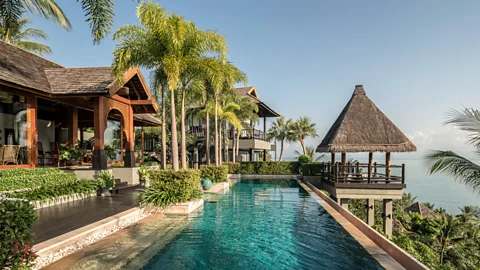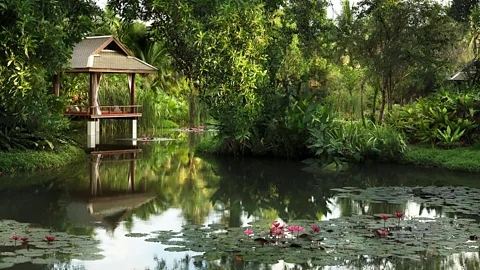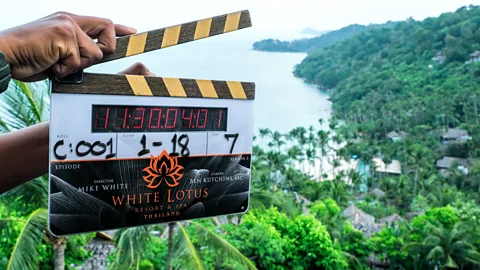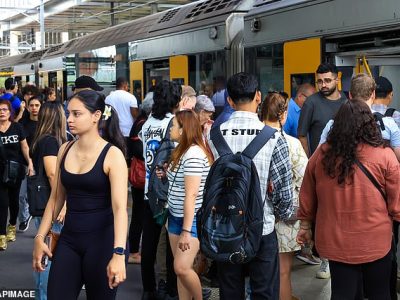 Fabio Lovino
Fabio LovinoAs White Lotus season three is released, executive producer Mark Kamine explains the behind-the-scenes wrangling and key challenges when choosing a filming location.
It’s being called the “White Lotus effect“: the way that major TV shows influence the way we travel, thanks to the hit TV show that’s back on 16 February 2025.
The black comedy-drama, written by Mike White, is in a new location for a third season, following the guests and staff of fictional five-star resort, the White Lotus. The dark drama satirises the excesses of the rich, set against the struggles of the staff, in a glamorous setting.
It’s thrilling, pacey stuff with beautiful people, gripping action and a tense setup that tells you from episode one, that although this looks like paradise, something terrible is going to happen. In the first season, a coffin is unloaded from a plane; while in the second, a body is discovered floating in the sea by a guest. Season three’s trailer is peppered with shots of guns and whispers of body bags amid the palm trees and luxury spa treatments.
The expectations come with a precedent: the Sicilian hotel, the Four Seasons San Domenico Palace in Taormina, Sicily, where season two was filmed, reported it was booked out for six months when it reopened after filming and continues to attract guests wanting a slice of the White Lotus lifestyle. The original White Lotus, the Four Seasons Resort Maui at Wailea, Hawaii, said it saw a 425% uptick year on year in website visits and 386% increase in availability checks.
 Four Seasons Koh Samui
Four Seasons Koh SamuiThe White Lotus isn’t the first drama to have an outsized effect on the travel industry – the impact of films like Lord of the Rings and The Sound of Music on tourism has been well documented, as has the much-criticised Emily in Paris. But what’s interesting right now, in the digital age, is how quickly news about a streamed TV show setting can have an impact.
“Back in 2015, research showed that around one in five people coming to Britain were coming because of something they’d seen on TV,” said screen tourism specialist Seren Welch. “Fast forward to now, and the latest Visit Britain research shows that nine in 10 visitors to the UK are influenced by what they have seen in film and TV. It’s unheard of.”
This rise is down to the prevalence of streaming platforms: as Welch notes, 10 years ago, we didn’t have Disney+ and Netflix was a lesser phenomenon. Today, streaming algorithms are powerful drivers of our behaviour far beyond the screen, with the opportunity to binge-watch everything anywhere leading viewers to be ever more immersed.
“I’ve heard a British Airways exec say that when they see a spike in traffic to a destination, they look at what’s peaking on Netflix to explain it,” Welch said.
What’s in a filming location?
When it comes to planning a location for a TV show like The White Lotus, Mark Kamine knows a thing or two. Kamine, one of The White Lotus’s executive producers, started his career as a location scout working on all six seasons of The Sopranos, along with film credits on Hollywood films including Ted, American Hustle and Silver Linings Playbook.
 Getty Images
Getty ImagesHis new book On Locations: Lessons Learned From my Life on Set with the Sopranos and in the Film Industry details the behind-the-scenes wrangling inherent in location work, from negotiating with strip club owners keen to do under-the-table deals, to pacifying home owners who have just found out you’ve staged a mafia killing in their house. It’s a lively read, running through the behind-the-scenes production level details about how to make one destination stand in for another on the tightest of tight budgets.
While many of Kamine’s previous film and TV productions have had financial issues constraining filming locations, when it came to The White Lotus, the wild success of the first seasons meant that when deciding the location for season three, there was plenty of choice.
“Mike White had the idea for something around Eastern philosophy,” Kamine explained. “We were looking for what was practical and eye-catching, and to start with, Korea, Philippines, Japan, Bali and Sri Lanka were in the mix, as well as Thailand.”
Further discussion and research narrowed the choice to Japan and Thailand, with White and Kamine and others making research trips to see what would work best. (White typically stays in the resort to write and research the show ahead of production.)
 Anantara Mai Khao Phuket
Anantara Mai Khao PhuketKamine notes in his book that the key challenges faced by location scouts centre on budgets: productions often end up being shot in dupe locations, where, for example, Prague might stand in for New Jersey, because even when subsidised, US locations can’t compete with European, Asian or African crew and material costs. But for a sure-fire hit like The White Lotus, which had a reported $38.5m budget for season two and drew in 4.1 million US viewers for its finale, Karmine and his team chose the option that reflected the story they wanted to tell best, rather than make a financial compromise.
“Mike said that he feels like we’ve cracked the code,” Kamine admitted, “in that we’ve figured out how to stay in these luxury locations and create great TV. What a life.”
“Anyone who has been to the Four Seasons in Sicily that we used in the show will know that the beach isn’t where it seems to be,” said Kamine. “Some scenes in season three are shot at one hotel, and some aspects are filmed elsewhere. The common spaces need to have real impact, that’s a driver here. Overall, the main thing is that it looks beautiful.”
The White Lotus team are aware of the impact the filming has on future bookings and the local tourism scene. Kamine says he keeps in touch with the hotel managers from the previous series and is aware of the debate around overtourism, noting that these popular five-star locations already have existing tourism infrastructure and have been developed to handle a certain number of visitors.
However, given that films shot in Thailand have driven a surge of tourism in the past – the extreme popularity of The Beach caused Maya Bay to close, for instance – it’s somewhat surprising to find that Thailand has no plan in place to mitigate a potential tourism surge from the show. A spokesperson from Tourism Thailand noted that the country is still trying to build back its tourism industry following Covid, and that since the show airs in Thailand’s shoulder season, it is most likely to boost tourism numbers in these quieter months when there is more capacity than in peak season.
 Fabio Lovino
Fabio LovinoWhere next?
The White Lotus isn’t the only streaming show boosting holiday bookings. As set-jetting continues to be a popular motif in the travel industry, new series including Yellowstone prequel 1923, set in Montana, are expected to drive more tourism. It’s not without its problems: in 2023, The Washington Post reported that Yellowstone has driven tourism to the region but has brought with it misconceptions: it does rain, it can be cold, and not everyone is as well dressed as the show would have you believe. That’s showbusiness.
Season two of Wednesday, also releasing this year, is a good case in point: the show is set in a fictional town in Vermont but season one was shot in Romania and season two filmed in Ireland. The final season of Stranger Things will air later this year as well, set in the town of Hawkins, Indiana but filmed in Jackson, Georgia. It’s a known filming location – The Walking Dead and The Vampire Diaries were also shot there – and the local tourism authority already has information on how to follow the shows around town. Tellingly, it notes that “the upside down is NOT included”.
As for The White Lotus, now that season three is out, thoughts are turning to season four. Kamine wouldn’t confirm or deny any location currently under discussion for the next series but did let slip that one thing is important: going back perhaps to his Soprano days, it needs to be somewhere where it’s easy to dump a body.











